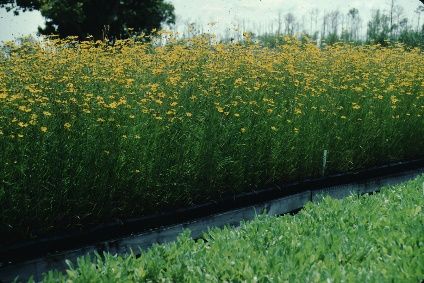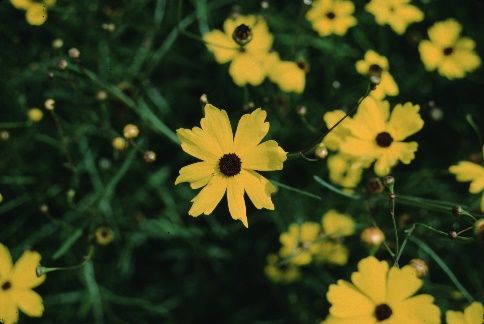Introduction
Thirteen coreopsis species occur in Florida, eleven of which are widely considered native to Florida. Coreopsis tinctoria is native to the U.S but is considered non-native in Florida. Coreopsis basalis is considered native by some and non-native by others. The genus coreopsis is Florida's state wildflower.
Coreopsis leavenworthii is found throughout Florida, and until recently was considered endemic. It is an annual to short-lived perennial. These colorful plants have pinnately to bipinnately compound leaves. In cultivation, this species has more foliage than what would normally be seen in the wild.
Flowers are bright yellow with a dark brown center. A very narrow orange "ring" around the brown disc flowers might even be noticed. These lovely flowers are held upright upon tall, leafless stems that enable the blooms to be beautifully incorporated into flower arrangements, although there is no information on how C. leaveworthii performs as a cut. The flowers are borne in capitula with small discs, and the ray florets have dentate tips. Flowers are 1 to 1½ inches in diameter; flowering is from late spring in north Florida to any time in south Florida.

Credit: Edward F. Gilman, UF/IFAS

Credit: Edward F. Gilman, UF/IFAS
General Information
Scientific name: Coreopsis leavenworthii
Pronunciation: kor-ree-OP-sis lev-en-WERTH-ee-eye
Common name(s): Leavenworth's tickseed
Family: Asteraceae
Plant type: herbaceous; annual to short-lived perennial
USDA hardiness zones: 8B through 11 (Figure 3)
Planting months for seed all zones: Sept through Jan
Planting months for transplants zones 8B and 9: mid Mar to May
Planting months for transplants zones 10 and 11: mid Feb to May
Origin: native to Florida
Invasive potential: may self-seed each year
Uses: edging; mass planting; attracts butterflies
Availability: somewhat available, may have to go out of your local area to find the plant

Credit:
Description
Height: 1 to 3 feet
Spread: 1 to 3 feet
Plant habit: upright
Plant density: open
Growth rate: moderate
Texture: fine
Foliage
Leaf arrangement: opposite/subopposite
Leaf type: pinnately to bipinnately compound
Leaf margin: entire
Leaf shape: linear to oblong
Leaf venation: not applicable
Leaf type and persistence: deciduous
Leaf blade length: 6 to 8 inches
Leaf color: green
Fall color: not applicable
Fall characteristic: not applicable
Flower
Flower color: yellow, with dark brown center
Flower characteristic: spring, summer, fall, winter; depending on region of Florida
Fruit
Fruit type: achene
Fruit shape: oval
Fruit length: 1/8 inch
Fruit cover: not applicable
Fruit color: brown
Fruit characteristic: inconspicuous and not showy
Trunk and Branches
Current year stem/twig color: green
Current year stem/twig thickness: thin
Culture
Light requirement: full sun to high pine shade
Soil tolerances: acidic; slightly alkaline; sand; loam; clay; occasionally wet
Drought tolerance: low
Soil salt tolerance: unknown, but probably low
Plant spacing: 6 to 12 inches
Other
Roots: not applicable
Winter interest: may flower during winter months in south Florida
Outstanding plant: not particularly outstanding
Pest resistance: no serious pests are normally seen on the plant
Use and Management
Coreopsis species are generally short-lived and may only last 3 to 4 seasons. Try using these plants as a border or edge. They are also excellent for naturalizing and will reseed themselves. The stalks become long and weak and tend to break in windy or rainy weather.
Coreopsis leavenworthii require a sunny position in the landscape. They prefer well-drained soils that are not too rich; rich soils and overwatering cause these plants to topple over. Keep the soil relatively moist and remove dead flowers immediately to prolong blooming. Place these plants 6 to 12 inches apart in the garden.
Seed is the most common method of propagation for coreopsis. Division can also be accomplished in the spring or fall.
Pests and Diseases
None observed.